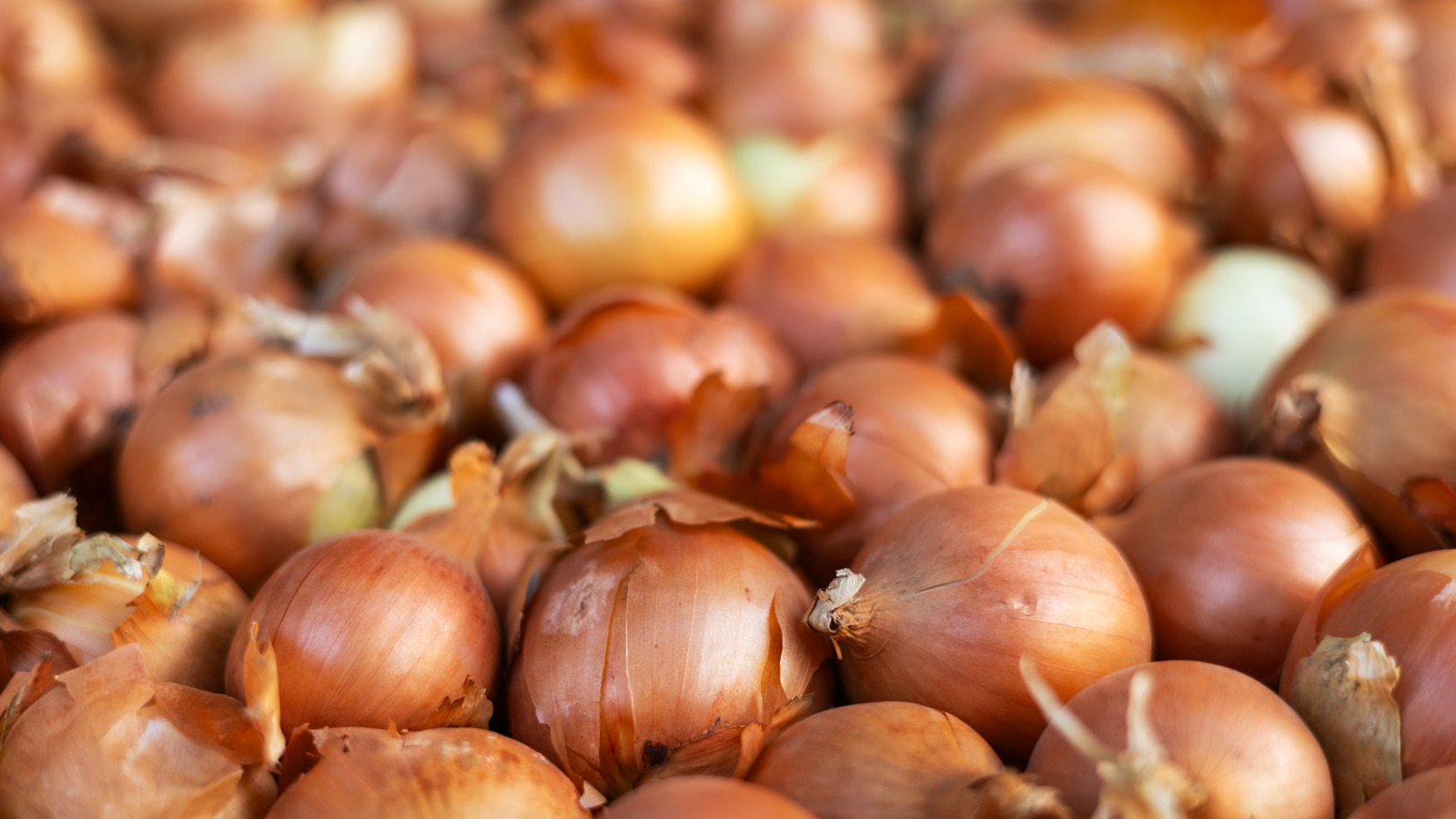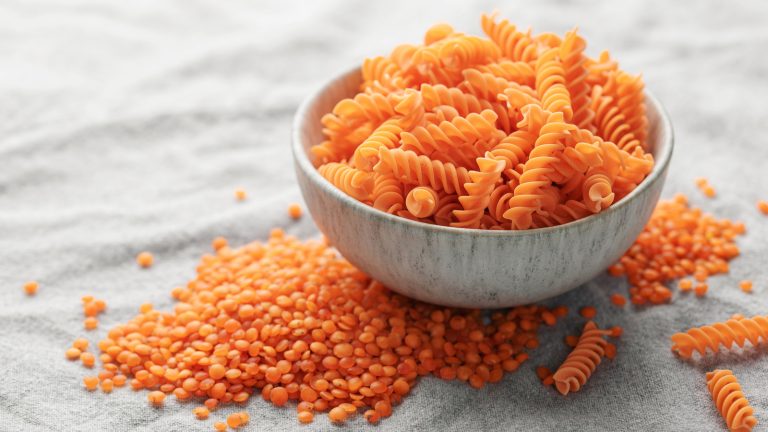When a recipe calls for an onion, many cooks default to the ubiquitous yellow onions that can be found piled high in bins at every supermarket. It’s true that in many recipes, yellow onions — with their relatively mild flavor and bite — are a safe choice. But if you want to add depth to your dishes, it’s a good idea to familiarize yourself with onion alternatives that can pack more of a punch.
Onions are grouped into three overarching categories based on color, taste, and growing season. Besides yellow onions, there are the more pungent white onions and the crisp, relatively mild red onions. But peel back the layers, and you’ll find dozens of subcategories and specialty options that go well beyond the basics.
Any plant in the allium genus is an onion, or at least onion adjacent. That includes familiar cooking staples like shallots, scallions, garlic, and even leeks. Chances are, you’ve cooked with a great many of these flavor-builders, including both onions proper as well as their offshoots. Many recipes work just fine with whatever allium you have on hand, as they are all capable of producing a biting, pungent essence that gives your dishes that little something extra. But if you master the ins and outs of onions, you can take even the most basic dishes from good to down-right wonderful.
1. Versatile yellow onions can stand the heat
Yellow onions are easily identifiable by their yellowish skin — onion growers aren’t the most creative when it comes to naming their produce. They’re typically harvested in late summer or early fall, as soon as the skins take on their distinctive color and their tops are green and standing tall.
Once they’re out of the ground, they’re ready to use immediately, though they can be stored whole in a cool, dry, dark place (like a pantry) for as long as two to three months, until they begin to show signs of sprouting or decay. Avoid storing them alongside potatoes, which release gases that can make your onions decay faster.
When you’re ready to cook with your yellow onions, start with your stovetop. They stand up well to heat, so they’re a good choice for caramelizing. Try out this easy steaming technique to caramelize onions faster if you’re pressed for time. And if your caramelized onions still aren’t quite up to Michelin standards, maybe the problem isn’t the onions, but the vinegar. Yellow onions hold their shape well, so they’re also great for sauteing in stir-fries. The longer they cook, the sweeter they taste, but they can be a little too sharp to eat raw, so choose other varieties for salads or burgers.
However you prepare them, yellow onions are a healthy choice. Besides being rich in antioxidants like quercetin, they also contain vitamin C and are a great source of prebiotic fiber.
2. White onions melt into soups and stews
There are plenty of similarities between yellow and onions, but there are some pronounced differences as well — besides color, that is. White onions have more of a bite than yellow onions, and can also be a little sweeter when eaten raw. The biggest difference, however, becomes apparent when they’re cooked.
Unlike yellow onions, white onions don’t hold their shape when heated. They turn translucent, and they can look like they’re in danger of melting away. The flavor, however, always sticks around. They’re best used in soups and stews, since the long simmering time allows them to almost dissolve into the dish. This cooking method can remove some — but not all — of the punch; you’ll definitely still be able to taste oniony goodness in every spoonful.
White onions have thinner skins than their yellow counterparts, so they can be harder to peel and prepare. If you’re eating them raw, as a garnish or in a salsa or dip, for instance, make sure to chop or dice them up small. When served this way, they can provide freshness and crunch without overpowering the rest of the dish.
White onions offer all the same health benefits as yellow onions, but researchers believe they might also play a role in triggering the immune system to ward off certain illnesses like jaundice. In addition, some practitioners of herbal medicine consider white onions to be a potent aphrodisiac.
3. Enjoy red onions cooked or raw
Easily identifiable by their purplish skin, red onions are sweet and mild when cooked. Eaten raw, they can be a little spicy — but still delicious. When cooking red onions, think low and slow, like roasting them in the oven to bring out a sweet, almost caramel flavor. Season them with salt and pepper, then enjoy with other roasted vegetables, over grilled steak, or just by themselves as a tasty side dish.
The most popular (and easiest) way to enjoy red onions, however, is raw. Get the most out of their mild, sweet flavor by adding them to salads. They also work great as a topping on burgers and sandwiches when sliced thinly. Use this hack to cut them to the perfect thickness every time. Red onions are also the go-to choice for pickling. Just soak them in a sugary brine, and in about an hour they’ll take on a bright, vinegary flavor that’s perfect for summer picnics.
The health benefits of red onions are thought to be more extensive than other allium varieties due to their higher levels of antioxidants. These antioxidants, especially quercetin and anthocyanin, are known to help prevent heart disease and high blood sugar. Additionally, a diet rich in red onions can improve gut health by contributing healthy bacteria to balance out some of the dangerous bacteria found in the digestive tract, like E. coli.
4. Vidalia onions are the kings of the sweets
If you’ve ever wanted to eat an onion like an apple, sweet onions are for you. Also known as spring onions because of the season in which they’re harvested, common varieties include Maui Sweets and California Imperials. The most popular and well-known sweet onion is the Vidalia. In the 1930s, word started spreading about the ultra sweet onions being grown in the small town of Vidalia, Georgia. Just a few decades later, Vidalia onions were the most popular sweet onion in America.
Vidalias and other sweet onions are great for baking and stuffing. In fact, they’re our only choice to use in casseroles. Sweet onions are gentler than other varieties, so expect less bite and pungency in your dishes. They make a great option when you still want some onion flavor but don’t want it to be the star of the show.
Because their sweetness fades quickly, sweet onions have a shorter shelf life than other onion varieties. It’s best to use them quickly, but they can be stored in an airtight container at room temperature for a couple of months. They can also be chopped and frozen if you want to stretch them even farther.
5. Shallots are the subtle choice
Shallots are small, round members of the allium family with a distinctive purplish flesh. A staple of classic French cooking, they’re used to build bases for sauces and vinaigrettes. They taste like a cross between red and yellow onions, with both a forward sweetness and a mild punch.
We wondered if shallots and onions could be used interchangeably, and in many instances, they can. In cooking, however, nuance can be important. The subtlety offered by shallots works in some dishes where a harsher onion flavor could overpower the lighter notes of the dish. For instance, use shallots instead of onions in egg dishes to highlight the flavors without masking them.
Another common place to use shallots instead of onions is in salad dressings. Summery vinaigrettes, in particular, benefit from the light touch of a shallot. Substituting in shallots can also bring out the flavor in typically bland chicken and poultry dishes. Sweating them in the pan before adding the meat easily lends subtle notes of needed flavor.
One advantage that shallots have over their larger counterparts is ease of storage. Like onions, shallots should be stored in a cool, dry place. Their much smaller size, however, means they take up much less space in the pantry.
6. Scallions, spring onions, and green onions are the same thing
Scallions or green onions are the flavorful shoots of a young or immature onion. The type of onion doesn’t matter; a scallion from a red onion is just as much a scallion as one from a yellow onion, without much difference in the flavor. Scallions are most often used for garnishing due to their mild bite and aesthetic qualities. Scattering chopped green onions as a finishing touch is also an effective way to add vibrant color to an otherwise monochromatic dish. The firmer, more pungent white ends have a different purpose, and are typically sauteed to create a flavorful base in sauces and soups.
Green onions are also a staple in East Asian cuisine where they’re commonly referred to as spring onions. They are often used as aromatics, but they move to the forefront in several traditional dishes. For example, the Shanghai specialty cong you ban mian features boiled noodles topped with soy sauce and a heaping of spring onions. Meanwhile, pa muchim is a traditional Korean salad that uses scallions as a base and dresses them in gochugaru and sesame oil.
Spring onions are also frequently used in traditional Asian medicine and healing. Eating scallions has long been associated with treating everything from depression to joint pain. Recent studies have shown that scallions do, in fact, have immune-boosting properties. Some researchers even believe they might have cancer-fighting capabilities due to their antioxidant content.
7. Walla Walla Sweets come with a legend
Walla Wallas have the best origin story of any onion: A 19th-century French soldier found an onion seed while stationed on the Isle of Corsica. Eventually, he settled in Walla Walla, Washington, and planted it. When his onions grew in, his neighbors were so impressed by their size and heartiness that they took some seeds for themselves. The following harvest, the neighbors all had their own special “French” onions. The onions spread across Walla Walla and now you can get them everywhere. Legally, though, they must be grown within a designated area in the state of Washington to be called a Walla Walla Sweet.
One of the most popular varieties of sweet onions, Walla Walla onions have an extremely high moisture content. True connoisseurs like to eat them raw, but their flavor and composition make them ideal for baking into pies and tarts. Like other sweet onions, their sweetness fades rather quickly, so they have a relatively short shelf life. It’s best to enjoy them as soon as they become available. They’re also a great choice for fried onion rings, thanks to their large shape and sweetness that shines through the heavy breading and oil.
8. Peel and roast Cipollini onions
With a relatively high sugar content, these mostly-flat, Italian onions caramelize nicely on the grill. Cipollini onions come in three colorful varieties: red, yellow, and white. About 2-inches in diameter, they pretty much all taste the same, regardless of color. When eaten raw, they have a mild bite and are a little sweeter than the average sweet onion. However, when cooked their flavor increases exponentially, which makes them a perfect choice for roasting. Their inherent sweetness also plays nicely with balsamic vinegar.
You have to peel the thin, papery skin before cooking them, which can be difficult to do by hand because the skins stick tightly to the flesh. Unless your knife skills are restaurant-grade, a paring knife won’t help much either because the onion’s small size makes peeling super intricate. The easiest way to do it is by blanching the onions the same way you would tomatoes. Use a paring knife to cut a small “x” on the bottom of each onion, and then dunk them in boiling water for about 30 seconds. Take them out, transfer them to an ice bath to stop the cooking, and the skins should just slide off.
9. Patterson onions are yellow, not mellow
Do you like onions but wish they were more extreme? Patterson onions might just be what you’re looking for. These yellow onion varieties are more-than-mildly pungent with a strong flavor to match. Use them when you want to supercharge dishes that typically call for yellow onions. For example, they could kick-start a batch of French onion soup that’s usually made with yellow onions. The recipe would be the same, but using Patterson onions would bring a bite of funk to the delicious and refined classic.
These onions are big, bold, and yellow, with an eerily uniform round shape that makes them easy to spot in the grocery store. Compared to other varieties of yellow onion, they’re typically a bit cheaper, so get more than you need. Due to their heartiness, they keep really well and are great to have stocked in the pantry. Gardeners might find Patterson onions to be a nice replacement for the yellow onions in their patch, as they are known for being low-maintenance and producing hearty yields.
10. Torpedo onions are versatile and sliceable
These Italian varieties are the least onion-looking onion you’ll likely come across, but don’t be fooled by the aesthetics. With their elongated shape and slender leaves, torpedo onions are mild enough to be eaten raw but are especially good when chopped, lightly cooked, and served over fish or as a pizza topping.
Torpedo onions typically grow to about 6 inches long and are an heirloom variety native to Calabria. Today they’re grown all over the world, most notably in northern California, and have a reputation for being easy to cultivate. With so many uses, however, there always seems to be a market for them.
Sometimes known as red torpedo onions, one of their defining characteristics is their sliceability. Even if you haven’t kept up with your knife sharpening routine, you’ll have no trouble getting paper-thin slices out of a torpedo. Use the slices as perfectly-cut condiments for your burgers and sandwiches. They are also superb pickling onions if canning is your thing, so go ahead and make condiments for next year’s burgers and sandwiches, too.
11. Bermuda onions aren’t all from Bermuda anymore
Once the go-to sweet onion for cooking, Bermuda onions have largely been replaced by cheaper, domestically grown varieties. Onions were first grown on the Caribbean island in the early 1600s. They were such a hit that just two centuries later onions and Bermuda were synonymous, and Americans even derisively called Bermuda “The Onion Patch.”
Milder than other sweet onions, the flavor and relatively flat shape of Bermuda onions make them ideal for grilling. They hold their form better than average, and the high heat of the grill basically steams them in their own juices. Those same juices also make Bermudas a solid choice for onion dips.
Like most sweet onions, they are high in fiber and antioxidants and touted for their health benefits. Buyer beware — Bermuda onions are not exclusively grown in Bermuda anymore. Many of the ones you’ll find in the U.S. come from Texas or California. If you want a real Bermuda onion experience, you’ll have to shop and source them carefully.
12. Pearl onions go great with cocktails
Mildly sweet pearl or baby onions can be difficult to prepare, as they typically must be blanched then peeled by hand. But once the prep work is complete, they work great as garnishes with meaty dishes like roast chicken, and can also be glazed or creamed and eaten as sides. There are dozens of ways to use pearl onions, and we know all the best ones.
Picking out good pearl onions at the grocery store can be tricky. Some are sold loose in bins, while others are grouped and sold in mesh bags. Either way, for the best onions, you’re going to have to look at each one individually. Make sure they are firm, moisture-free, and have smooth, papery skin.
Pickled pearl onions are used to garnish some of our favorite cocktails, like Gibsons, Spanish gin and tonics, and even Bloody Marys. To make them, briefly cook the pearl onions in a simple salt and sugar brine, let them cool, and then seal them with the brine in a jar. You can even get fancy and add aromatics like lemon and juniper.





